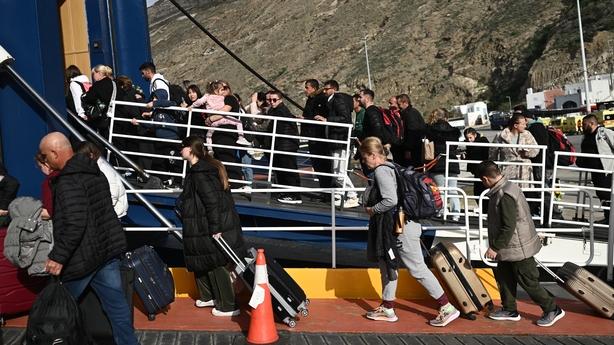Greek Prime Minister Kyriakos Mitsotakis has appealed for calm after a wave of seismic tremors hit the tourist island of Santorini, prompting mass departures.
Speaking from Brussels, Mr Mitsotakis acknowledged authorities were monitoring a "very intense" geological phenomenon over recent days, adding: "I want to ask our islanders above all to remain calm."
Known for its spectacular cliffside views and a dormant volcano, Santorini and neighbouring Aegean Sea islands have been hit by hundreds of tremors since last week, the largest with a magnitude of 4.9.


Schools remained shut and additional flights were scheduled to help people leave the island.
Tremors have been recorded between the volcanic islands of Santorini and Amorgos in the Aegean Sea since Friday, forcing authorities to close schools in Santorini and the nearby islands of Ios, Amorgos and Anafi.
Quakes, some with a magnitude above 4, rattled Santorini every few minutes today as people were advised to stay out of indoor spaces and small ports. Disaster response units were deployed on the ground as a precaution.
Experts have said that the seismic activity on the island, some of whose most populated areas are perched on steep cliffs, will continue for weeks.
"We estimate it (the activity) will continue for some days and there could be a lengthy seismic sequence," Efthymios Lekkas, a professor of tectonic geology and disaster management, and part of a team of experts assessing the situation on the ground, told Greek television.
Local officials said that permanent residents were not particularly worried as they have been used to quakes but some who were on the island for work were moving out.
Aegean Airlines said it would operate three additional flights to and from Santorini today and tomorrow to facilitate the travel of residents and visitors upon a request by Greece's Civil Protection Ministry.
Greece sits on multiple fault lines and is often rattled by earthquakes.
One of the largest volcanic eruptions in history, around 1600 BC, formed Santorini in its current shape. The last eruption in the area occurred in 1950.
Experts said a mild volcanic activity also recorded near Santorini in recent days was not linked to the quakes.

